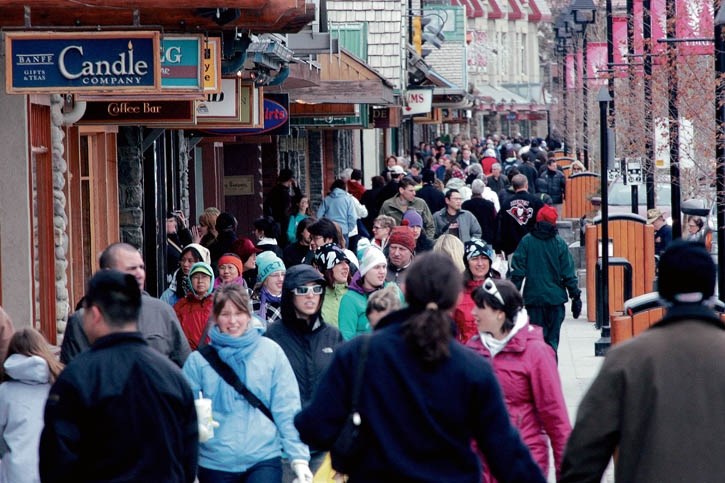The federal government has announced temporary foreign workers hired in the tourism industry for periods of six months or less are exempt from program caps, making it easier for Bow Valley businesses to hire badly-needed staff for the 2016 season.
Local and Canadian tourism organizations welcome confirmation that tourism jobs are considered low-wage seasonal positions that are eligible to certain exemptions under the controversial Temporary Foreign Worker program.
“We are pleased that the government has provided clarification on the ‘seasonal’ industries that will be eligible to hire TFWs to work for up to 180 days,” said Darren Reeder, executive director of Banff and Lake Louise Hospitality Association.
“The announcement is a positive development for many of our tourism industry partners who have been struggling to attract a sufficient number of workers to meet their summer labour requirements.”
Tourism businesses will be eligible to hire some TFWs outside the 10 per cent cap limit. This is a temporary measure until the government conducts its review of the program, and will apply only to the 2016 summer season.
Temporary foreign workers who are hired for a period of less than 180 days will not be included in cap limit calculations of 20 per cent, and 10 per cent once the cap is reduced on July 1.
According to a study released late last year, Banff experienced a shortage of more than 400 workers in July last year alone, at the same time visitor numbers to the tourist town continued to soar.
Each business interviewed, on average, reported a shortage of 21 employees. Guest room attendants represent the largest shortfall at 106, which is the number of staff needed to clean a 1,136-room hotel.
Other jobs under pressure were kitchen help, line cooks and food and beverage servers.
Reeder said BLLHA has been actively collecting and analyzing labour market data within the national park over the past year.
“That allowed us to confirm how many people short we were last summer and to model a few scenarios that revealed that a large labour shortage was likely to meet us in the summer of 2016,” he said.
“While BLLHA determined that there was a high rate of employee turnover in many employment categories, the consistently hardest positions to staff include light duty cleaners, cooks, food and beverage servers and kitchen help/dishwashers.”
Reeder said BLLHA predicts Banff and Lake Louise would see an average of 239 workers short of their summer hiring needs in the months of April through November.
“July is the highest needs month with a projected deficit of 345 workers,” he said.
Mayor Karen Sorensen said the federal government’s decision is good news for Banff, noting it will help build staffing requirements to appropriate levels.
“We’ve had a really busy couple of summers and 2016 seems to be on target to be even busier, and then into 2017 with the 150th anniversary we know the volumes of visitors are going to increase,” she said.
“That’s all good news, but we want our visitors to have a positive visitor experience, and a shortage of staff is very trying on employers and can leave visitors without the levels of service they deserve.”
Sorensen said BLLHA has worked tirelessly on this issue with all levels of government.
“My huge gratitude to BLLHA. They have been an incredibly strong voice on this issue from the get-go,” she said. “Although there’s a lot more work to be done, this is a win and I credit a lot of that to BLLHA’s efforts.”
Tourism industry officials say they recognize this is a temporary measure, noting they continue to work with partners and government to find longer term solutions to labour shortages.
This includes developing a comprehensive strategy to engage with the parliamentary review of the TFW program set to take place later this year.
Reeder said BLLHA will work closely with national tourism partners to present an evidence-based argument that demonstrates the tourism industry requires a stable, long-term seasonal tourism worker program.
He said, however, that TFW exemption would not deter BLLHA from pursuing a broader set of ideas intended to stabilize the Banff and Lake Louise labour market for the long-term for hiring Canadians.
“It is really important that we find different ways to introduce more young Canadians to the opportunities that exist in the tourism industry,” said Reeder.
“Over the coming months BLLHA will be tackling this both from an education and job fair front, but also through enhanced marketing efforts and the development of regional labour partnerships.”
The $1,000 fee per worker and LIMA requirements still apply.
Businesses can apply for as many 180-day positions as they want. All applications of TFWs of 180 or less must be made in one bulk application. Only applications can be submitted under this exemption, but that application can cover multiple temporary foreign workers.
A spokesperson for the Minister of Employment, Workforce Development and Labour, MaryAnn Mihychuk, was not available for comment by press time.




